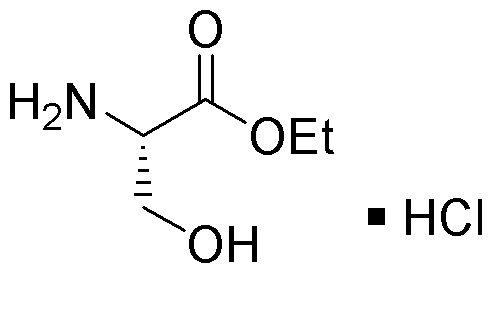L-Serine ethyl ester hydrochloride is widely utilized in research focused on
- Biochemical Research: It serves as a precursor in the synthesis of various amino acids and peptides, making it essential for researchers studying protein synthesis and metabolic pathways.
- Pharmaceutical Development: This compound is explored for its potential neuroprotective effects, which can be beneficial in developing treatments for neurodegenerative diseases.
- Food Industry: It can be used as a flavor enhancer or nutritional supplement, providing an additional source of amino acids in functional foods.
- Cosmetic Formulations: L-Serine ethyl ester hydrochloride is incorporated into skincare products for its moisturizing properties, helping to improve skin hydration and texture.
- Biotechnology: It is utilized in cell culture media to support the growth of various cell types, aiding in research and development of biopharmaceuticals.
General Information
Properties
Safety and Regulations
Applications
L-Serine ethyl ester hydrochloride is widely utilized in research focused on
- Biochemical Research: It serves as a precursor in the synthesis of various amino acids and peptides, making it essential for researchers studying protein synthesis and metabolic pathways.
- Pharmaceutical Development: This compound is explored for its potential neuroprotective effects, which can be beneficial in developing treatments for neurodegenerative diseases.
- Food Industry: It can be used as a flavor enhancer or nutritional supplement, providing an additional source of amino acids in functional foods.
- Cosmetic Formulations: L-Serine ethyl ester hydrochloride is incorporated into skincare products for its moisturizing properties, helping to improve skin hydration and texture.
- Biotechnology: It is utilized in cell culture media to support the growth of various cell types, aiding in research and development of biopharmaceuticals.
Documents
Safety Data Sheets (SDS)
The SDS provides comprehensive safety information on handling, storage, and disposal of the product.
Product Specification (PS)
The PS provides a comprehensive breakdown of the product’s properties, including chemical composition, physical state, purity, and storage requirements. It also details acceptable quality ranges and the product's intended applications.
Certificates of Analysis (COA)
Search for Certificates of Analysis (COA) by entering the products Lot Number. Lot and Batch Numbers can be found on a product’s label following the words ‘Lot’ or ‘Batch’.
*Catalog Number
*Lot Number
Certificates Of Origin (COO)
This COO confirms the country where the product was manufactured, and also details the materials and components used in it and whether it is derived from natural, synthetic, or other specific sources. This certificate may be required for customs, trade, and regulatory compliance.
*Catalog Number
*Lot Number
Safety Data Sheets (SDS)
The SDS provides comprehensive safety information on handling, storage, and disposal of the product.
DownloadProduct Specification (PS)
The PS provides a comprehensive breakdown of the product’s properties, including chemical composition, physical state, purity, and storage requirements. It also details acceptable quality ranges and the product's intended applications.
DownloadCertificates of Analysis (COA)
Search for Certificates of Analysis (COA) by entering the products Lot Number. Lot and Batch Numbers can be found on a product’s label following the words ‘Lot’ or ‘Batch’.
*Catalog Number
*Lot Number
Certificates Of Origin (COO)
This COO confirms the country where the product was manufactured, and also details the materials and components used in it and whether it is derived from natural, synthetic, or other specific sources. This certificate may be required for customs, trade, and regulatory compliance.


